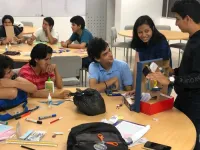(Press-News.org) Researchers have successfully demonstrated the UK’s first long-distance ultra-secure transfer of data over a quantum communications network, including the UK’s first long-distance quantum-secured video call.
The team, from the Universities of Bristol and Cambridge, created the network, which uses standard fibreoptic infrastructure, but relies on a variety of quantum phenomena to enable ultra-secure data transfer.
The network uses two types of quantum key distribution (QKD) schemes: ‘unhackable’ encryption keys hidden inside particles of light; and distributed entanglement: a phenomenon that causes quantum particles to be intrinsically linked.
The researchers demonstrated the capabilities of the network via a live, quantum-secure video conference link, the transfer of encrypted medical data, and secure remote access to a distributed data centre. The data was successfully transmitted between Bristol and Cambridge – a fibre distance of over 410 kilometres.
This is the first time that a long-distance network, encompassing different quantum-secure technologies such as entanglement distribution, has been successfully demonstrated. The researchers presented their results at the 2025 Optical Fiber Communications Conference (OFC) in San Francisco.
Quantum communications offer unparalleled security advantages compared to classical telecommunications solutions. These technologies are immune against future cyber-attacks, even with quantum computers, which – once fully developed – will have the potential to break through even the strongest cryptographic methods currently in use.
In the past few years, researchers have been working to build and use quantum communication networks. China recently set up a massive network that covers 4,600 kilometres by connecting five cities using both fibreoptics and satellites. In Madrid, researchers created a smaller network with nine connection points that use different types of QKD to securely share information.
In 2019, researchers at Cambridge and Toshiba demonstrated a metro scale quantum network operating at record key rates of millions of key bits per second. And in 2020, researchers in Bristol built a network that could share entanglement between multiple users. Similar quantum network trials have been demonstrated in Singapore, Italy and the USA.
Despite this progress, no one has built a large, long-distance network that can handle both types of QKD, entanglement distribution, and regular data transmission all at once, until now.
The experiment demonstrates the potential of quantum networks to accommodate different quantum-secure approaches simultaneously with classical communications infrastructure. It was carried out using the UK’s Quantum Network (UKQN), established over the last decade by the same team, supported by funding from the Engineering and Physical Sciences Research Council (EPSRC), and as part of the Quantum Communications Hub project.
“This is a crucial step toward building a quantum-secured future for our communities and society,” said co-author Dr Rui Wang, Lecturer for Future Optical Networks in the Smart Internet Lab's High Performance Network Research Group at the University of Bristol. “More importantly, it lays the foundation for a large-scale quantum internet—connecting quantum nodes and devices through entanglement and teleportation on a global scale.”
“This marks the culmination of more than ten years of work to design and build the UK Quantum Network,” said co-author Adrian Wonfor from Cambridge’s Department of Engineering. “Not only does it demonstrate the use of multiple quantum communications technologies, but also the secure key management systems required to allow seamless end-to-end encryption between us.”
“This is a significant step in delivering quantum security for the communications we all rely upon in our daily lives at a national scale.” said co-author Professor Richard Penty, also from Cambridge and who headed the Quantum Networks work package in the Quantum Communications Hub. “It would not have been possible without the close collaboration of the two teams at Cambridge and Bristol, the support of our industrial partners Toshiba, BT, Adtran and Cisco, and our funders at UKRI.”
“This is an extraordinary achievement which highlights the UK’s world-class strengths in quantum networking technology,” said Gerald Buller, Director of the IQN Hub, based at Heriot-Watt University. “This exciting demonstration is precisely the kind of work the Integrated Quantum Networks Hub will support over the coming years, developing the technologies, protocols and standards which will establish a resilient, future-proof, national quantum communications infrastructure.”
The current UKQN covers two metropolitan quantum networks around Bristol and Cambridge, which are connected via a ‘backbone’ of four long-distance optical fibre links spanning 410 kilometres with three intermediate nodes.
The network uses single-mode fibre over the EPSRC National Dark Fibre Facility (which provides dedicated fibre for research purposes), and low-loss optical switches allowing network reconfiguration of both classical and quantum signal traffic.
The team will pursue this work further through a newly funded EPSRC project, the Integrated Quantum Networks Hub, whose vision is to establish quantum networks at all distance scales, from local networking of quantum processors to national-scale entanglement networks for quantum-safe communication, distributed computing and sensing, all the way to intercontinental networking via low-earth orbit satellites.
END
Researchers demonstrate the UK’s first long-distance ultra-secure communication over a quantum network
2025-04-07
ELSE PRESS RELEASES FROM THIS DATE:
One in 3,000 people at risk of punctured lung from faulty gene – almost 100 times higher than previous estimate
2025-04-07
As many as one in 3,000 people could be carrying a faulty gene that significantly increases their risk of a punctured lung, according to new estimates from Cambridge researchers. Previous estimates had put this risk closer to one in 200,000 people.
The gene in question, FLCN, is linked to a condition known as Birt-Hogg-Dubé syndrome, symptoms of which include benign skin tumours, lung cysts, and an increased risk of kidney cancer.
In a study published today in the journal Thorax, a team from the University of Cambridge examined data from UK Biobank, the 100,000 Genomes Project, and East London Genes & Health – three large genomic datasets encompassing more than ...
Creativity and problem-solving: How design thinking transforms university teaching
2025-04-07
Thinking creatively, solving complex problems, and working in teams… all add up to Design Thinking (DT). A study conducted by the Escuela Superior Politécnica del Litoral (ESPOL) and Ghent University provides a step-by-step guide for teaching this methodology as a university course.
The main objective of this study is to share the implementation of DT in the first year of all undergraduate programs at ESPOL, considering that previous research has shown that this course fosters essential DT skills in a world of constant change, allowing students to build their own knowledge through experiential learning.
In practice, this study ...
American College of Cardiology recognizes 2025 Young Investigator Award recipients
2025-04-07
The American College of Cardiology is recognizing the 2025 winners of its Young Investigator Awards, which took place at the ACC’s Annual Scientific Session (ACC.25) in Chicago.
The Young Investigator Awards competition invites promising, young scientific investigators to present their cutting-edge research. The finalists competed in three categories: Basic and Translational Science, Clinical Investigations and Outcomes Research. This year’s awardees are:
Young Investigator Awards in Basic ...
Coding differences in Medicare Advantage plans led to $33 billion in excess revenue to insurers
2025-04-07
Embargoed for release until 5:00 p.m. ET on Monday 7 April 2025
Follow @Annalsofim on X, Facebook, Instagram, threads, and Linkedin
Below please find summaries of new articles that will be published in the next issue of Annals of Internal Medicine. The summaries are not intended to substitute for the full articles as a source of information. This information is under strict embargo and by taking it into possession, media representatives are committing to the ...
CAS and Cleveland Clinic collaborate to accelerate research through advanced AI and quantum computing
2025-04-07
Columbus, OH; Cleveland, OH, April 7, 2025 – CAS, a division of the American Chemical Society specializing in scientific content and knowledge management, and Cleveland Clinic, an academic health system with a global footprint, announced plans for a strategic collaboration that will unite the organizations’ unique expertise, technology, and data capabilities to fuel clinical research.
During the Cleveland Discovery & Innovation Forum, an event highlighting cutting-edge healthcare and life sciences research, the two global organizations announced that their collaboration’s ...
Fees can help the FDA ensure food safety
2025-04-07
The Food and Drug Administration (FDA) collects user fees from drug and medical device companies to fund its work ensuring the safety of these products. Creating a similar program that collects fees from food companies could generate much-needed resources to strengthen the FDA’s oversight of foods, according to a new legal and policy analysis published in the journal Health Affairs.
“The FDA is persistently understaffed and underfunded, hampering its ability to ensure the safety of our country’s food supply,” said Jennifer Pomeranz, associate professor of public health policy and management at NYU ...
Medically tailored meal programs could yield significant health care savings across 49 US states
2025-04-07
While Food is Medicine programs are successfully helping patients manage their health, many initiatives are small-scale pilots, providing treatment to several hundred or several thousand patients. Results of these studies have demonstrated that these nutrition-based food prescription programs improve a range of health outcomes for patients with diet-sensitive conditions, while also potentially saving in medical costs, suggesting wider implementation and investment would lead to long-term savings and a healthier population.
To ...
Sarah Sjöström, MSN, RN, ACNP-BC, named chief nursing officer at Hebrew SeniorLife
2025-04-07
Sarah Sjöström, MSN, RN, ACNP-BC, has been promoted to chief nursing officer at Hebrew SeniorLife.
Sjöström joined Hebrew SeniorLife in 2010 as a staff nurse, later became director of nursing in the Medical Acute Care Unit, was promoted to associate chief nursing officer in 2017, and gained the vice president of ancillary services responsibilities in 2023.
She is co-chair of Hebrew SeniorLife’s Age-Friendly Committee and, through that work and as associate chief nursing officer, has championed quality of care and age-friendly practices across the organization. In 2021, she received a John A. Hartford Foundation scholarship to participate in the ...
Transparency in government is good for global health
2025-04-07
When are you most forthcoming with life updates? And when are you the most transparent about exactly what those updates are? For most folks — show of hands, please — it’s when things are going well. Sharing our wins is in our nature; our losses, typically, not so much.
Not surprisingly, governments are similarly inclined. Yet, it turns out, broad government transparency not only breeds goodwill, begetting still more transparency — it can change lives for the better.
Researchers Sarah Anderson and Mark Buntaine, of UC Santa Barbara’s Bren School of Environmental Science & Management, and colleagues ...
Dust in the Wind: How cities alter natural airborne particles
2025-04-07
Airborne dust pollution is a growing problem for residente of Utah and other Western states, especially with the exposed lakebed of Great Salt Lake potentially becoming more hazardous as the lake dries. Natural dust blows from the Great Basin and settles along the western edge of the Wasatch Front, Utah’s major population center, and the surrounding mountains. While airborne, the dust mixes with local human-made materials, potentially contaminating the nearby watershed and resulting in other negative consequences, according ...


